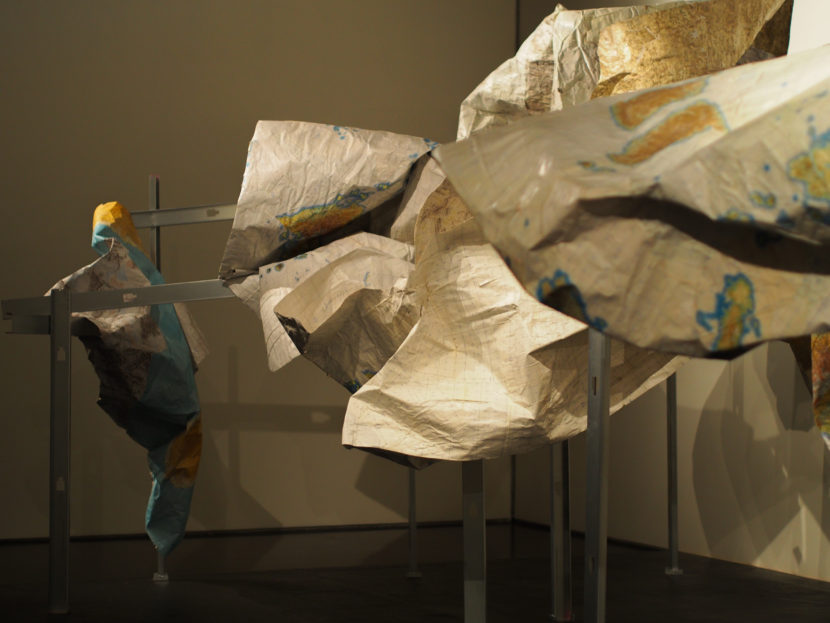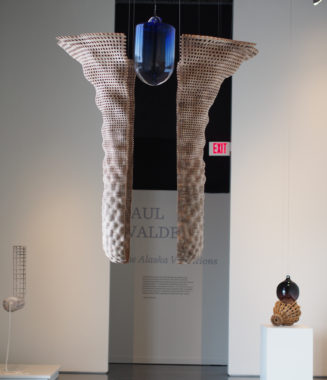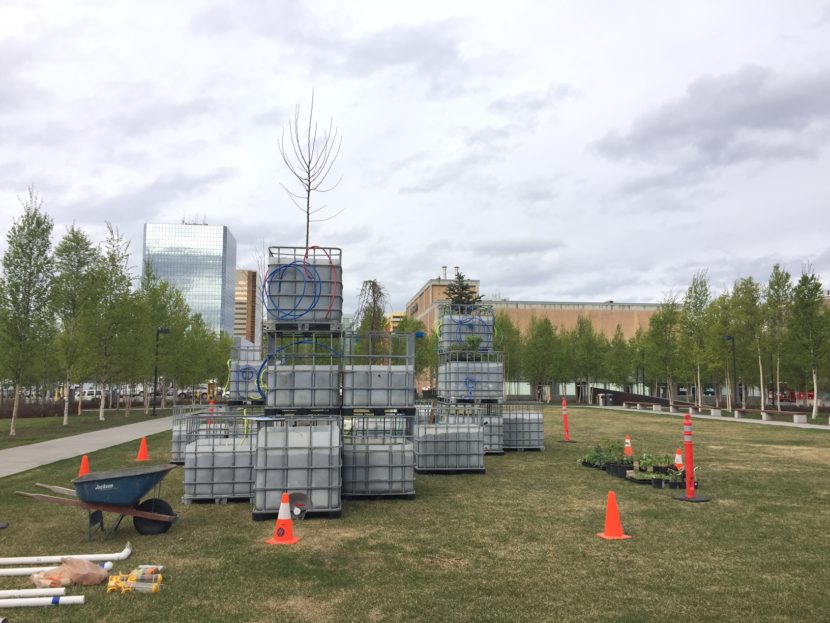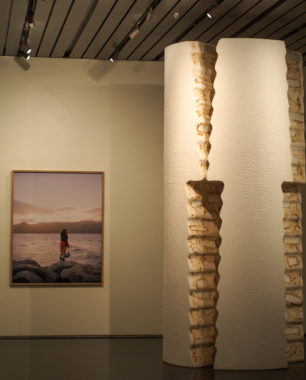
When people imagine Alaska’s Arctic, experimental art isn’t typically the first thing that comes to mind.
But a new exhibit at the Anchorage Museum is getting visitors, urbanites, and art-lovers to connect to the Arctic in different ways. And the works expand well beyond the gallery walls.
Standing outside the Anchorage museum during busy mid-day traffic, two radio producers from Brooklyn plug earbuds into an iPhone as they get ready to test a sound walk.
“A sound walk is like a museum audio tour, but it’s outside,” explained Isaac Kestenbaum, who has spent the last few months in Alaska as part of a project called “Frontier of Change,” a partnership with public radio station KNBA in Anchorage.
Kestenbaum, along with his collaborator and wife Josie Holtzman, is about to try their mile-long sound walk for the first time together, taking notes about how they can improve it for visitors in the days ahead.
“There’s just a lot of imagining that you have to do,” Holtzman explained of the challenges for synchronizing audio and the surrounding environment.

The two set out on the same route groups of guided guests will travel starting Friday. They slipped pairs of headphones into their ears, the dangling cords connecting to a smartphone loaded with a 31-minute podcast.
“I’d like to welcome you aboard Frontier of Change Airlines,” begins a flight attendant (voiced by Holtzman) in the audio file. “Non-stop service to Shaktoolik, by way of downtown Anchorage.”
The experimental piece isn’t actually about Anchorage, but instead Shaktoolik, a community of around 300 people hundreds of miles off the road system.
“You’ll be traveling in two places at once,” chimes the recording.
It’s a little discombobulating: my eyes are looking at traffic lights and JC Penny’s, but in my ears are the wind and waves you hear walking down the man-made berm separating Shaktoolik’s 61 homes from the Bering Sea.
“Shaktoolik is one mile long, and a little bit wider than this city block,” the flight attendant voice pipes in.
Across the street from the museum, we begin meeting people from around town.”
“Welcome to Shaktoolik,” says Mayor Eugene Asicksick. “Stormy Shaktoolik, I should say.”
A lot of what Asicksick and others talk about is the shifting climate: What warming winters, worsening storms, and a growing day-to-day fear over the weather feel like in the small town.
“It’s changing,” Asicksick says in the recording. “But to me, that’s home.”
Rounding the corner, a 15-story luxury hotel comes into view just as Shaktoolik teacher Lynda Bekoalok describes how her 11-year-old students talk about evacuating in a flood.
“They said, ‘I’d take water, and I would take food, and I’d take Band-Aids and I’d grab my VHF.’ Where before they’d grab toys, their phones, their video games,” says Bekoalok in a concerned by considered tone. “Their whole way of thinking is different.”
As the sound walk continued, the urban surroundings that can feel insulated from climate change began feeling closer to it. At times, was hard to tell if the airplanes I was hearing were from the earbuds or the actual Cessna’s overhead on their way to Merrill Field. Same with the buzzing hum of trucks, the wind, and seagulls.
As Holtzman scribbled notes after the tour, I asked if the Shaktoolik sound walk downtown is supposed to be a complement, a contradiction, or both.

This is just one of the experimental pieces in “The View From Up Here” exhibit. Most of the installations are inside the museum–although the lawn is playing host to an “arctic food forest.”
Derek Cote grew up in rural Canada and now teaches in Detroit. His video piece “Legends Are Made Here” (with an accompanying score by Paul Haas, played the Anchorage Symphony Orchestra) started years ago when the museum invited him to experiment with a new format during his time as an artist-in-residence.

At one point in Cote’s film the burning pink globe of a shallow sunrise outside Shishmaref is shown alongside the lush red curtain rising at Anchorage’s Performing Arts Center. The movements and music harmonize on the screen, which is no accident.
“I think there’s a lot of dichotomy here that I’ve experienced, sort of the urban and the rural and remote, and I’m trying to find ways to reconcile those two,” Cote said.
The show’s theme is loose, and most of the works look nothing alike. There are sculptures of glass and wood suspended from the ceiling like ornamental cocoons, a multimedia display of prehistoric permafrost patterns, even a vinyl record made from wood burned during a bonfire in Kotzebue that you can listen to through headphones.
Museum director Julie Decker says the idea was to give support to several artists with long-standing ties to northern regions as they explore this particular point in time for Alaska’s Arctic.
“There’s always been a fascination with the Arctic, and with the North, and so artists have come to these places for centuries,” Decker said.
“But there’s an urgency to the story now, and there’s an increased curiosity because of the rapid pace of change,” she added.
The View From Up Here opens Friday and runs through October 6th.
The “Frontier of Change” sound walk will be available online at KNBA through the end of the summer.